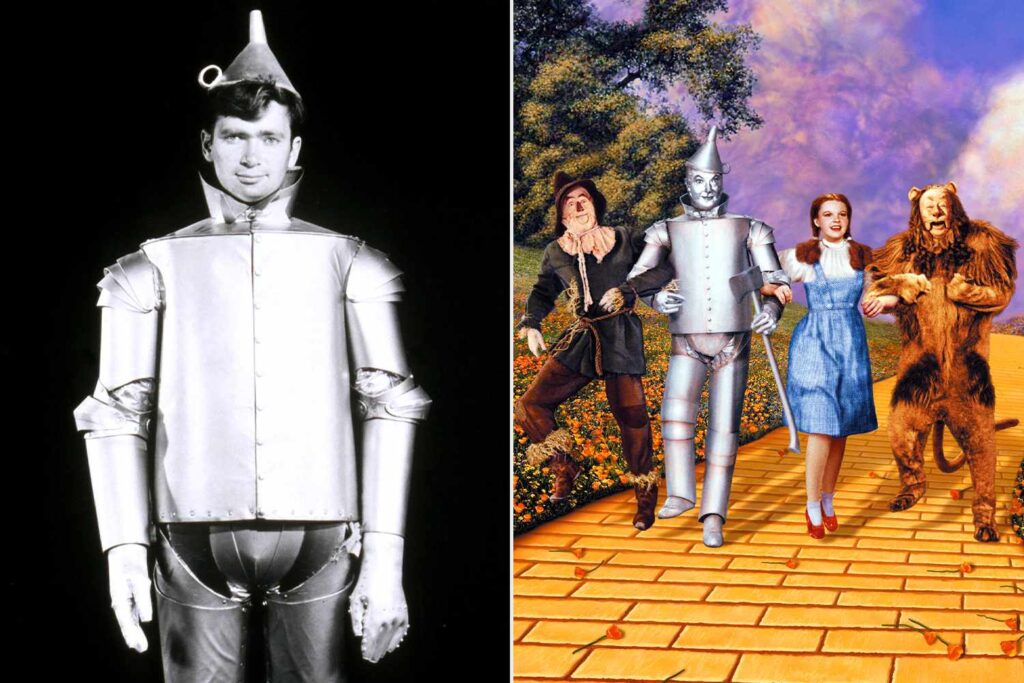NEED TO KNOW
In The Wizard of Oz, the Tin Man famously sings “If I Only Had a Heart.”
But for Buddy Ebsen, the actor originally cast the Tin Man in the 1939 classic, it wasn’t his heart that was an issue: After filming for 10 days, he was rushed to the hospital after the aluminum dust from his makeup coated his lungs and made it nearly impossible for him to breathe.
“I wondered if I was dying,” he later wrote to a journalist.
Ebsen wasn’t supposed to play the Tin Man in the first place, Oz historian John Fricke tells PEOPLE. Ebsen — who’d later go on to star as Jed Clampett in the 1962-71 CBS sitcom The Beverly Hillbillies — was under contract with MGM in the 1930s. MGM songwriter Arthur Freed was looking to move into producing, and wanted to develop a musical project for young actress Judy Garland.
He settled on The Wizard of Oz, and began casting from MGM’s talent pool, choosing Ray Bolger for the Tin Man and Ebsen for the Scarecrow, two of the characters Dorothy Gale (Garland) meets on the Yellow Brick Road after a tornado whisks her from Kansas to Oz. (Bert Lahr played the Cowardly Lion.)
John Springer Collection/CORBIS/Corbis via Getty
Ebsen already filmed with Garland on The Broadway Melody of 1938 and “was delighted at the idea of working with Judy again,” says Fricke, the author of The Wizard of Oz, The Official 50th Anniversary Pictorial History and The Wizard of Oz, An Illustrated Companion to the Timeless Movie Classic.
So it didn’t matter to him when Bolger expressed interest in swapping roles.
“As Buddy often said, after that, he didn’t mind because he knew Oz was going to be this huge technicolor production, and it was always good to be in a movie of that caliber and that size, especially in a leading role,” says Fricke.
When shooting began in October 1938, Ebsen’s “basic makeup was clown white, the stuff that clowns used to paint their faces white in the circus,” says Fricke. “And this was then dusted every day, multiple times, with aluminum particles, ground-up little bits of aluminum that would then adhere to the clown white and make him look silver and shiny.”
Fricke has a copy of a note Ebsen — who died in 2003 at 95 — once typed up, relaying his ordeal to a reporter. He quotes from it to PEOPLE.
Silver Screen Collection/Hulton Archive/Getty
“So when they finally got the effect they wanted with my makeup, I took a deep breath of relief. Unfortunately, two weeks later, I could hardly breathe at all. Production had been underway for 10 days when one night after dinner I took a breath and nothing happened. It felt like no air had reached my lungs. This was a most frightening moment. They called an ambulance and took me to Good Samaritan Hospital. My lungs felt as though someone had coated them with glue. My breathing was excruciatingly labored, no oxygen seemed to reach my lungs,” Ebsen wrote.
“I wondered if I was dying. No one seemed to know what was wrong or what the outcome was going to be. Tests revealed that my lungs were coated with the aluminum dust with which they’d been powdering my face,” he continued.
“The strange thing was that back then, pure aluminum dust in the lungs was considered harmless. I was in the hospital under an oxygen tent for two weeks, and went from there to the Coronado Hotel in San Diego to recuperate. MGM had to get on with the picture and gave the role to Jack Haley. I spent a month at the Coronado and finally felt well enough to go home,” he added.
Courtesy Everett
“And how did Jack Haley make out with the makeup? No problem. They didn’t want to lose him too, so they applied the aluminum dust as a paste. They mixed it in with the clown white, and they pasted it on, and he didn’t inhale any of it,” wrote Ebsen, accoring to Fricke.
But the historian notes that Haley didn’t get away unscathed from the aluminum paste, which had gotten too close to his eye: “Ultimately, it gave him a bad eye infection, and he was off the picture for a number of days. But that wasn’t anything life-threatening.”
Though Ebsen was replaced by Haley, Ebsen remains in the movie.
“Jack Haley re-recorded ‘If I Only Had a Heart.’ But then when they meet the Tin Man and then when they meet the Cowardly Lion, those versions of ‘We’re Off to See the Wizard’ had been pre-recorded with Judy, Ray, Buddy, and Bert, and those remain in the film. So his voice is still there on the track,” notes Fricke.
Wicked: For Good — the the sequel to last year’s Wicked, an origin story of the Wicked Witch of the West and Glinda — shows Dorothy’s arrival in Oz as well as the origin of the Tin Man (as interpreted by Wicked author Gregory Maguire).
The collision of the two worlds, Wicked director Jon M. Chu recently told PEOPLE, is “the thing we’ve all been waiting for.”

